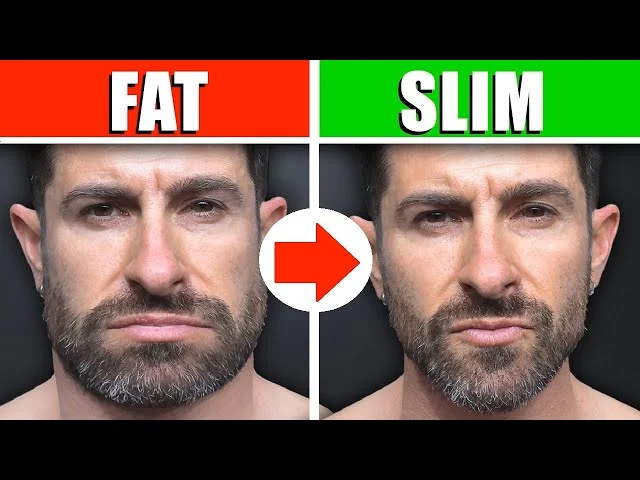Losing face fat is a common goal for many individuals striving for a more sculpted and defined facial appearance. While it’s not possible to target fat loss in just one specific area, certain strategies can help reduce overall body fat, which will in turn lead to a slimmer face. This guide will dive deep into understanding face fat, the most effective exercises, dietary recommendations, lifestyle changes, and additional tips to help you achieve a leaner face.
1. How to Lose Face Fat
Understanding Face Fat: Causes and Contributing Factors
Face fat is often the result of a combination of factors, including overall body weight, genetics, and lifestyle habits. Here’s a closer look at these elements:
- Genetics: Your genetic makeup plays a significant role in determining where your body stores fat. Some people are predisposed to store more fat in their face and neck areas.
- Overall Body Weight: Typically, if you carry extra weight, it’s likely to show in your face. The face, along with the abdomen and hips, is a common area where excess fat is stored.
- Water Retention: High sodium intake, dehydration, and hormonal fluctuations can lead to water retention, causing the face to appear puffier.
- Aging: As you age, your skin loses elasticity and collagen, which can cause the face to appear fuller or saggy.
- Poor Diet: Consuming a diet high in processed foods, sugars, and unhealthy fats can contribute to weight gain, including in the face.
Understanding the root causes of face fat can help you tailor your approach to effectively reduce it.
2. Effective Exercises to Tone Your Face and Reduce Face Fat
While spot reduction isn’t feasible, facial exercises can tone and strengthen the muscles in your face, contributing to a more defined appearance. Below are detailed exercises you can incorporate into your routine:
- Cheek Puff Exercise:
- How to Perform: Sit comfortably and take a deep breath. Puff out your cheeks with air and hold for 10 seconds. Push the air from one cheek to the other, holding each side for 5 seconds.
- Benefits: This exercise strengthens the cheek muscles and helps reduce the appearance of chubby cheeks.
- Jawline Exercise:
- How to Perform: Tilt your head back, look at the ceiling, and push your lower jaw forward to feel a stretch under the chin. Hold this position for 10-15 seconds, then relax.
- Benefits: This exercise targets the area under the chin and helps in reducing a double chin, enhancing the jawline.
- Fish Face Exercise:
- How to Perform: Suck in your cheeks and lips as if making a fish face. Hold for 10-15 seconds and repeat 10 times.
- Benefits: This exercise works on the muscles around your cheeks and chin, giving a more toned appearance to the face.
- Neck Roll:
- How to Perform: Sit or stand up straight, and slowly rotate your head in a circular motion. Perform 10 rotations clockwise and then 10 counterclockwise.
- Benefits: Neck rolls relieve tension in the neck and jaw muscles and help in reducing the appearance of a double chin.
- Smile and Hold:
- How to Perform: Smile as wide as you can while keeping your lips closed. Hold this position for 10-15 seconds and then relax. Repeat 10 times.
- Benefits: This simple exercise helps to lift and tone the cheek muscles, contributing to a slimmer face.
3. Dietary Changes to Help Lose Face Fat
What you eat greatly influences your overall body fat, including in the face. Making strategic dietary changes can support fat loss and lead to a more defined facial structure.
- Reduce Caloric Intake:
- Caloric Deficit: To lose fat, you need to consume fewer calories than your body burns. Use a calorie calculator to determine your daily caloric needs and aim to reduce your intake by 500-1000 calories per day for gradual fat loss.
- Nutrient-Dense Foods: Focus on whole, unprocessed foods like vegetables, fruits, lean proteins (such as chicken, tofu, and legumes), and whole grains. These foods are low in calories but high in essential nutrients, keeping you full longer.
- Stay Hydrated:
- Importance of Water: Drinking enough water helps flush out toxins and reduces water retention, which can make your face appear less bloated.
- Daily Intake: Aim for at least 8 glasses (about 2 liters) of water per day. If you’re physically active or live in a hot climate, you may need more.
- Limit Sugar and Refined Carbs:
- Impact on Weight Gain: High sugar intake and refined carbs (like white bread, pasta, and sugary snacks) can cause insulin spikes, leading to increased fat storage.
- Healthy Substitutes: Replace refined carbs with complex carbohydrates like quinoa, brown rice, and whole wheat products. Opt for natural sweeteners like honey or stevia instead of sugar.
- Increase Fiber Intake:
- Role of Fiber: Foods high in fiber help regulate digestion and keep you feeling full, which can prevent overeating.
- Sources of Fiber: Include plenty of vegetables, fruits, legumes, and whole grains in your diet. Aim for at least 25-30 grams of fiber per day.
- Reduce Sodium Intake:
- Sodium and Water Retention: High sodium intake can lead to water retention, making your face look puffier.
- Tips to Cut Sodium: Avoid processed and packaged foods, which are often high in sodium. Use herbs and spices to season your meals instead of salt.
4. Lifestyle Changes for Reducing Face Fat
Adopting a healthy lifestyle is crucial for long-term fat loss. These changes not only help reduce face fat but also improve your overall well-being.
- Regular Exercise:
- Cardio: Cardiovascular exercises like running, swimming, cycling, and jumping rope are excellent for burning calories and reducing body fat. Aim for at least 150 minutes of moderate-intensity cardio each week.
- Strength Training: Building muscle through strength training (using weights, resistance bands, or bodyweight exercises) increases your metabolism, helping you burn more calories even at rest.
- Get Enough Sleep:
- Sleep and Fat Loss: Lack of sleep increases cortisol levels, which can lead to weight gain and fat retention, particularly around the face.
- Sleep Tips: Establish a regular sleep routine, aiming for 7-8 hours of uninterrupted sleep per night. Avoid screens and caffeine before bedtime.
- Manage Stress:
- Stress and Weight Gain: Chronic stress can lead to emotional eating and increased cortisol levels, which contribute to fat storage, including in the face.
- Stress Management Techniques: Practice mindfulness, yoga, meditation, or deep breathing exercises to reduce stress. Regular physical activity also helps manage stress levels.
- Limit Alcohol Consumption:
- Alcohol and Bloating: Alcohol dehydrates the body, leading to water retention and bloating, particularly in the face. It’s also high in empty calories, which can contribute to weight gain.
- Moderation: If you drink, do so in moderation. Opt for lower-calorie options like dry wine or spirits mixed with soda water instead of sugary cocktails.
5. Additional Tips to Slim Down Your Face
In addition to exercise, diet, and lifestyle changes, there are some additional techniques you can use to reduce the appearance of face fat:
- Facial Massage:
- Benefits: Regular facial massage stimulates blood circulation, reduces puffiness, and can help contour the face over time.
- How to Do It: Use gentle upward strokes with your fingertips or a facial roller to massage your face for 5-10 minutes daily.
- Use Cold Compresses:
- Benefits: Applying a cold compress or ice pack to your face can reduce swelling and tighten the skin, giving a slimmer appearance.
- How to Use: Wrap ice cubes in a cloth and gently apply them to your face, focusing on the cheeks, jawline, and under the eyes.
- Posture Correction:
- Impact on Facial Fat: Poor posture, especially slouching, can lead to the accumulation of fat around the neck and chin area, contributing to a double chin.
- Posture Tips: Sit and stand up straight, keep your shoulders back, and hold your head high to improve your posture and reduce the appearance of a double chin.
- Makeup Techniques:
- Contouring: Using makeup to contour your face can create the illusion of a slimmer face. Apply a darker shade of foundation or bronzer along the jawline, under the cheekbones, and around the temples, and highlight the high points of your face to enhance your natural bone structure.
6. Debunking Myths About Face Fat Loss
There are many misconceptions about face fat loss. It’s important to understand what works and what doesn’t:
- Myth 1: Spot Reduction Is Possible:
- Reality: Spot reduction, or losing fat from a specific area, is not possible. Fat loss occurs uniformly throughout the body. Focus on overall fat reduction through diet and exercise.
- Myth 2: Facial Creams Can Reduce Face Fat:
- Reality: No topical creams can effectively reduce face fat. They may temporarily tighten the skin or reduce puffiness, but they won’t eliminate fat.
- Myth 3: Chewing Gum Burns Face Fat:
- Reality: While chewing gum may exercise your jaw muscles, it’s not an effective method for reducing face fat. It may, however, help with cravings by keeping your mouth occupied.
Conclusion: Achieving a Slimmer Face
Losing face fat requires a holistic approach that combines regular exercise, a balanced diet, healthy lifestyle habits, and targeted facial exercises. While genetics and overall body weight play a significant role, adopting these strategies can help you achieve a more defined and sculpted facial appearance.
Remember, consistency is key. It’s important to be patient and maintain a positive mindset throughout your journey. Celebrate small victories along the way, and stay committed to your goals. With time and effort, you’ll not only see a reduction in face fat, but also enjoy improved overall health and confidence.



